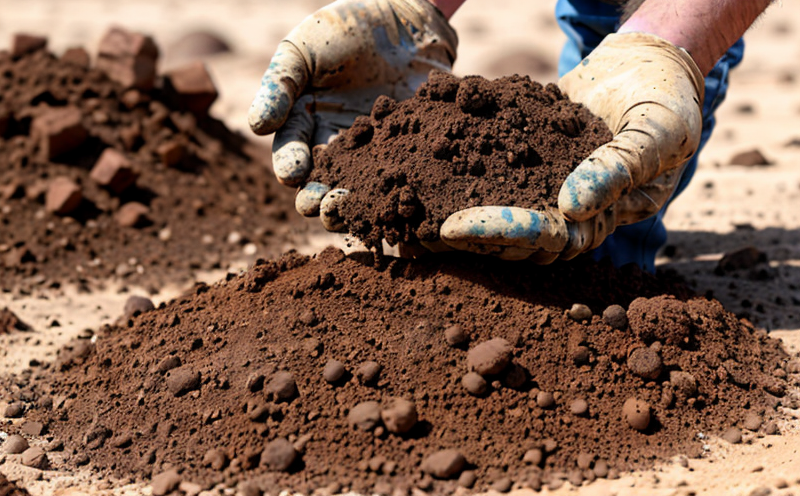BS EN ISO 22476 Cone Penetration Test Soil Characterization
The BS EN ISO 22476 Cone Penetration Test (CPT) is a widely recognized geotechnical testing method used to characterize the soil and overburden layers beneath structures and foundations. This standardized approach allows for the assessment of soil properties, including penetration resistance, frictional resistance, and pore water pressure effects. The CPT provides essential data that supports decision-making in foundation design, environmental assessments, and infrastructure planning.
The test method involves driving a conical probe into the ground at a controlled rate while measuring the force required to penetrate through different soil layers. This process generates a series of penetration resistance values (σ1) which are used to characterize various soil types based on their physical properties and engineering behavior.
The BS EN ISO 22476 CPT is particularly valuable in mining operations where accurate soil characterization is critical for ensuring safety, optimizing extraction processes, and minimizing environmental impacts. It allows for the assessment of both near-surface and deeper soil layers, providing a comprehensive understanding of the subsoil conditions.
The test procedure ensures consistency and reliability through standardized methods that are recognized globally. This standardization supports international collaboration and compliance with regulatory requirements in various countries. The BS EN ISO 22476 CPT is widely adopted by mining companies, construction firms, and environmental consultancies to meet the specific needs of their projects.
The test results can be used to determine the suitability of different soil layers for mining operations, including assessing the stability of slopes and the potential for landslides. It also helps in understanding the impact of mining activities on local ecosystems and groundwater resources.
For accurate testing, it is crucial to follow the detailed procedures outlined in BS EN ISO 22476. This includes selecting appropriate probe types and sizes, ensuring proper installation of sensors, and calibrating equipment before each test run. The data collected during the CPT can be used to develop geotechnical models that accurately reflect the subsurface conditions.
The BS EN ISO 22476 standard has been revised to include enhanced methods for measuring frictional resistance (φ) and pore water pressure effects, which are critical factors in mining operations. These improvements ensure more precise characterizations of soil layers, leading to better-informed decisions regarding mining practices.
| Aspect | Description |
|---|---|
| Penetration Resistance (σ1) | The force required to penetrate the soil, indicating soil strength and density. |
| Frictional Resistance (φ) | The resistance offered by soil layers as they slide past each other during excavation. |
| Pore Water Pressure Effects | The pressure exerted by water in the soil pores, affecting stability and settlement. |
Industry Applications
- Evaluating subsurface conditions for mining operations.
- Determining the suitability of different soil layers for excavation.
- Assessing slope stability and potential landslide risks.
- Supporting environmental impact assessments in mining regions.
- Optimizing foundation designs for mining facilities.
- Ensuring compliance with international standards like BS EN ISO 22476.
- Providing accurate data for geotechnical modeling and simulations.
- Supporting sustainable mining practices by minimizing environmental impacts.
Environmental and Sustainability Contributions
The BS EN ISO 22476 CPT plays a crucial role in promoting sustainability in the mining sector. By accurately characterizing soil layers, this test helps minimize the risk of environmental degradation caused by improper excavation practices. It supports the development of sustainable mining plans that balance economic goals with ecological considerations.
The test results can be used to identify areas where mining activities could have adverse effects on local ecosystems and groundwater resources. This knowledge enables miners to implement targeted mitigation strategies, ensuring minimal disruption to natural habitats.
Additionally, the BS EN ISO 22476 CPT supports the optimization of resource use in mining operations. By understanding soil properties accurately, miners can design more efficient extraction processes that reduce waste and energy consumption. This contributes to a circular economy approach, where resources are used as effectively as possible before being recycled or reprocessed.
The test also helps in predicting long-term impacts of mining activities on the environment. With accurate data on subsurface conditions, environmental consultancies can provide more reliable predictions about potential changes in local ecosystems and climate patterns. This information is invaluable for developing strategies that promote environmental resilience and adaptability.
Use Cases and Application Examples
- Evaluating the stability of spoil heaps in open-pit mines.
- Determining the appropriate locations for underground mine galleries.
- Assessing the risk of slope failures in surface mining operations.
- Supporting environmental impact assessments by identifying sensitive areas.
- The BS EN ISO 22476 CPT is used to determine the bearing capacity of soil layers suitable for foundation construction.
- It helps in designing mine layouts that minimize surface disturbance and protect water resources.
- This test supports the development of reclamation plans by providing data on subsurface conditions before and after mining activities.





